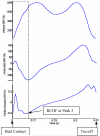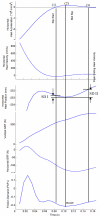Effects of 8 weeks of balance or weight training for the independently living elderly on the outcomes of induced slips
- PMID: 19773670
- PMCID: PMC2929758
- DOI: 10.1097/MRR.0b013e32832e6b5e
Effects of 8 weeks of balance or weight training for the independently living elderly on the outcomes of induced slips
Abstract
The study was conducted to evaluate whether the balance or weight training could alter gait characteristics of elderly contributing to a reduction in the likelihood of slip-induced falls. A total of 18 elderly were evaluated for the study. The results indicated decreases in heel contact velocities and the friction demand characteristics after 8 weeks of training, although fundamental gait characteristics, such as walking velocity and step length, were not changed. The results also indicated an increase in transitional acceleration of the whole body center of mass. The number of falls after 8 weeks was reduced in training groups. These findings were found in conjunction with the improvements in knee flexor muscle and plantarflexor muscle strength. In conclusion, after training, elderly were less likely to initiate slips and more likely to recover from slips.
Figures




Similar articles
-
Positive effects of resistance training in frail elderly patients with dementia after long-term physical restraint.Age (Dordr). 2014 Apr;36(2):801-11. doi: 10.1007/s11357-013-9599-7. Epub 2013 Nov 16. Age (Dordr). 2014. PMID: 24243397 Free PMC article.
-
Characterizing slip-like responses during gait using an entire support surface perturbation: Comparisons to previously established slip methods.Gait Posture. 2019 Mar;69:130-135. doi: 10.1016/j.gaitpost.2019.01.033. Epub 2019 Jan 23. Gait Posture. 2019. PMID: 30708096
-
Falls study: Proprioception, postural stability, and slips.Biomed Mater Eng. 2015;26 Suppl 1:S693-703. doi: 10.3233/BME-151361. Biomed Mater Eng. 2015. PMID: 26406065 Clinical Trial.
-
Exercise for preventing falls in older people living in the community.Cochrane Database Syst Rev. 2019 Jan 31;1(1):CD012424. doi: 10.1002/14651858.CD012424.pub2. Cochrane Database Syst Rev. 2019. PMID: 30703272 Free PMC article.
-
Provoking Artificial Slips and Trips towards Perturbation-Based Balance Training: A Narrative Review.Sensors (Basel). 2022 Nov 28;22(23):9254. doi: 10.3390/s22239254. Sensors (Basel). 2022. PMID: 36501958 Free PMC article. Review.
Cited by
-
Growing Relevance of Cardiac Rehabilitation for an Older Population With Heart Failure.J Card Fail. 2016 Dec;22(12):1015-1022. doi: 10.1016/j.cardfail.2016.10.010. Epub 2016 Oct 18. J Card Fail. 2016. PMID: 27769907 Free PMC article. Review.
-
Which Exercise Interventions Can Most Effectively Improve Reactive Balance in Older Adults? A Systematic Review and Network Meta-Analysis.Front Aging Neurosci. 2022 Jan 18;13:764826. doi: 10.3389/fnagi.2021.764826. eCollection 2021. Front Aging Neurosci. 2022. PMID: 35115917 Free PMC article.
-
Effects of a Fall Prevention Exercise Program on Muscle Strength and Balance of the Old-old Elderly.J Phys Ther Sci. 2014 Nov;26(11):1771-4. doi: 10.1589/jpts.26.1771. Epub 2014 Nov 13. J Phys Ther Sci. 2014. PMID: 25435697 Free PMC article.
-
Never Too Old for Cardiac Rehabilitation.Clin Geriatr Med. 2019 Nov;35(4):407-421. doi: 10.1016/j.cger.2019.07.001. Epub 2019 Jul 2. Clin Geriatr Med. 2019. PMID: 31543175 Free PMC article. Review.
-
Treadmill-gait slip training in community-dwelling older adults: mechanisms of immediate adaptation for a progressive ascending-mixed-intensity protocol.Exp Brain Res. 2019 Sep;237(9):2305-2317. doi: 10.1007/s00221-019-05582-3. Epub 2019 Jul 8. Exp Brain Res. 2019. PMID: 31286173 Free PMC article.
References
-
- Aagaard P, Simonsen Erik B., Andersen Jesper L., Magnusson Peter, Dyhre-Poulsen Poul. Increased rate of force development and neural drive of human skeletal muscle following resistance training. Journal of Applied Physiology. 2003;93(4):1318–1326. - PubMed
-
- Barnett A, Ben S, Stephen R, Mandy W, Adrian B. Community-based group exercise improves balance and reduces falls in at-risk older people: a randomized controlled trial. Age and Ageing. 2003;32:407–414. - PubMed
-
- Buchner D, Elaine C, Barbara L, Esselman P, Margherita A, Price R, Wagner E. The effect of strength and endurance training on gait, balance, fall risk, and health services use in community-living older adults. J Gerontol Med Sci. 1997;52A:M218–M224. - PubMed
-
- Chen IH, Kuo KN, Andriacchi TP. The influence of walking speed on mechanical joint power during gait. Gait and Posture. 1997;6:171–176.
-
- Connelly D, Vandervoort A. Effects of isokinetic strength training on concentric and eccentric torque development in the ankle dorsiflexors of older adults. The Journal of Gerontology Series: Biol Sciences and Med Sciences. 2000;55:B465–B472. - PubMed
Publication types
MeSH terms
Grants and funding
LinkOut - more resources
Full Text Sources
Medical

